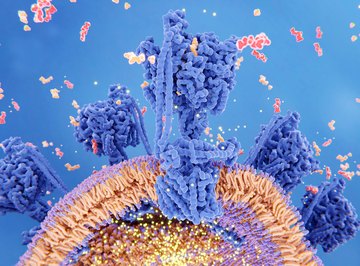
The Krebs cycle, named after German-British biochemist Hans Adolf Krebs, is a key part of cellular metabolism.
To grow and carry out their functions in the body, cells have to metabolize glucose to produce energy. They can then use this energy to synthesize the organic molecules the body needs and for specific functions such as movement in muscle cells or digestion in the stomach. In 1937, Krebs discovered the Krebs cycle reaction, also known as the citric acid cycle, that forms a major part of this metabolic process.
In the course of splitting and metabolizing glucose molecules, cells have to make sure that the many body variables such as temperature, heart beat and respiration are maintained at stable levels. Homeostasis describes the process by which cells regulate the effects of hormones, enzymes and metabolism to keep the body working properly, within safe limits.
As part of glucose metabolism, the regulation of Krebs cycle helps cells with their homeostasis.
How Metabolism Maintains Homeostasis
Advanced organisms take in nutrients and metabolize them so that they can carry on their normal activities. The main source of metabolic energy is the breakdown of glucose into carbon dioxide and water in the presence of oxygen.
To maintain homeostasis, the levels of glucose, oxygen and the metabolic products all have to be tightly regulated. Each step of the metabolic process, including the Krebs cycle steps, helps regulate the organic substances it controls.
The main metabolic steps include the following:
- Digestion
- Food is introduced into the oral cavity. The breakdown of carbohydrates starts with saliva.
- Swallowed food enters the stomach. Gastric juices further digest the food.
- Complex carbohydrates are broken down into glucose and other byproducts in the intestines. The glucose is absorbed by the walls of the intestines and enters the blood stream.
- Cellular Respiration
- Blood with oxygen from the lungs and glucose from the intestines is pumped out to the capillaries where the oxygen and glucose diffuse into individual cells.
- Inside each cell, a chemical reaction called glycolysis splits the glucose molecules and produces enzymes and energy-carrying molecules called ATP (adenosine triphosphate).
- The Krebs cycle steps use some of the enzymes produced by glycolysis to produce additional enzymes, more ATP and carbon dioxide.
- The enzymes produced by glycolysis and the Krebs cycle enter the electron transport chain and produce a large number of ATP molecules. The final hydrogen reaction products combine with oxygen to form water.
- Elimination
- The carbon dioxide and water diffuse out of the cells into the blood stream and are passed back to the heart through the veins.
- The blood is pumped through the lungs to eliminate carbon dioxide and through the kidneys to eliminate surplus water.
For each step, the body, its organs and its cells have to keep body variables such as temperature, glucose levels and blood pressure steady at normal levels. This homeostatic regulation is controlled by the action of hormones and enzymes that are required for each step of metabolism to proceed.
If there is too much or too little of a particular substance, an enzyme will speed up or slow down the corresponding metabolic steps until homeostasis is established again.
The Example of Glucose Homeostasis
Glucose is the principal input for cellular respiration and its byproducts are used in the Krebs cycle. The level of glucose in the blood has to be controlled within a tight range. If there is not enough glucose reaching the cells, they will no longer be able to use cellular respiration and the Krebs cycle as an energy source. Instead, they may start breaking down fats or even muscle tissue.
Having too much glucose in the blood can be harmful as well. First, the body tries to get rid of the extra glucose by removing it from the blood in the kidneys and eliminating it through urine. Excessive urination dehydrates the body and increases the concentration of glucose in the blood. If the glucose level becomes too high, the individual may fall into a coma.
Glucose regulation is controlled by the pancreas.
If the level of glucose in the blood is too high, the pancreas releases insulin into the blood stream. Insulin promotes the use of glucose in the cells and helps with cellular respiration. The glucose level in the blood then decreases. If the glucose level is too low, the pancreas signals the liver to release more glucose. The liver is able to store excess glucose and releases it to help maintain glucose homeostasis.
The Krebs Cycle Steps
The main function of the Krebs cycle is to convert enzymes that the electron transport chain uses to produce energy. The cycle is self-contained in that it re-uses its constituent chemicals in a constantly repeating sequence. The enzymes NAD and FAD are changed to high-energy molecules NADH and FADH2 that can power the electron transport chain.
The Krebs cycle is made up of the following steps:
- The pyruvate molecules created by splitting glucose during glycolysis enter the cell mitochondria where an enzyme metabolizes them into Acetyl CoA to start the Krebs cycle.
- The acetyl group combines with a four-carbon oxaloacetate to form a citrate.
- The citrate loses two carbon molecules to form two carbon dioxide molecules, using the energy from the broken bonds to produce two NADH molecules.
- An oxaloacetate molecule is regenerated, producing an FADH2 molecule and a further NADH molecule.
- The oxaloacetate molecule is available for another cycle at the start of a new sequence of reactions.
- The NADH and FADH2 molecules migrate to the inner membrane of the mitochondria where they power the electron transport chain.
Through its role in cellular respiration, the Krebs cycle influences glucose homeostasis. Through regulation of glucose metabolism, it can play an important role in overall homeostasis in the body.
The Enzymes in Cellular Respiration
The enzymes that are produced during cellular respiration help keep cells in homeostasis.
Molecules such as NAD and FAD are needed for the Krebs cycle and the electron transport chain to proceed. Additional enzymes speed up or slow down the Krebs cycle depending on cell signaling. Cells send signals to indicate an imbalance and request the Krebs cycle to help maintain homeostasis for the substances and variables it can influence.
Since the Krebs cycle forms part of the metabolic chain that uses glucose and oxygen while producing carbon dioxide and water, the cycle can influence the levels of these four substances and trigger adjustments in other metabolic functions. For example, if a high rate of metabolism is required because the body is undertaking strenuous activity, the oxygen levels in cells may go down. A slowing Krebs cycle forces the body to breathe more rapidly and the heart to pump faster, delivering the required oxygen to the cells.
The same type of mechanism can influence triggers such as hunger, thirst or attempts to raise or lower body temperature. Hunger and thirst will cause an individual to look for food and water. Someone who feels too hot will sweat, look for shade and remove items of clothing. Someone who feels cold will shiver, look for a warm spot and add clothing layers.
Through its unique role in cell metabolism, the Krebs cycle helps maintain homeostasis in the body and influences behavior as well.
References
About the Author
Bert Markgraf is a freelance writer with a strong science and engineering background. He has written for scientific publications such as the HVDC Newsletter and the Energy and Automation Journal. Online he has written extensively on science-related topics in math, physics, chemistry and biology and has been published on sites such as Digital Landing and Reference.com He holds a Bachelor of Science degree from McGill University.
